2022 NISSAN ARMADA roof
[x] Cancel search: roofPage 10 of 604
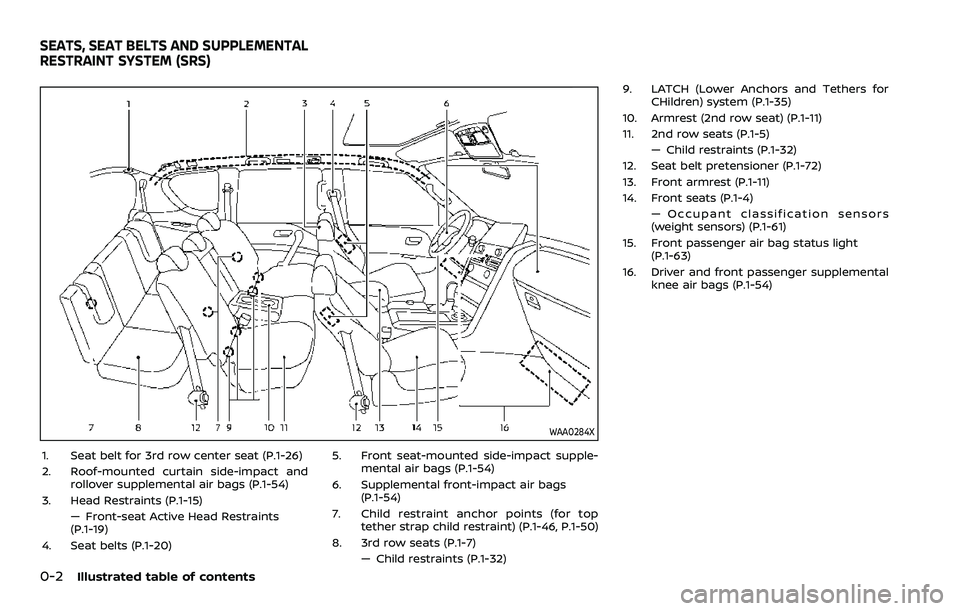
0-2Illustrated table of contents
WAA0284X
1. Seat belt for 3rd row center seat (P.1-26)
2. Roof-mounted curtain side-impact androllover supplemental air bags (P.1-54)
3. Head Restraints (P.1-15) — Front-seat Active Head Restraints
(P.1-19)
4. Seat belts (P.1-20) 5. Front seat-mounted side-impact supple-
mental air bags (P.1-54)
6. Supplemental front-impact air bags (P.1-54)
7. Child restraint anchor points (for top tether strap child restraint) (P.1-46, P.1-50)
8. 3rd row seats (P.1-7) — Child restraints (P.1-32) 9. LATCH (Lower Anchors and Tethers for
CHildren) system (P.1-35)
10. Armrest (2nd row seat) (P.1-11)
11. 2nd row seats (P.1-5) — Child restraints (P.1-32)
12. Seat belt pretensioner (P.1-72)
13. Front armrest (P.1-11)
14. Front seats (P.1-4) — Occupant classification sensors
(weight sensors) (P.1-61)
15. Front passenger air bag status light (P.1-63)
16. Driver and front passenger supplemental knee air bags (P.1-54)
SEATS, SEAT BELTS AND SUPPLEMENTAL
RESTRAINT SYSTEM (SRS)
Page 11 of 604

WAA0285X
1. Hood (P.3-21)
2. Windshield wiper and washer— Switch operation (P.2-42)
— Window washer fluid (P.8-10)
— Windshield wiper deicer (if so equipped)
(P.2-46)
3. Moonroof (if so equipped) (P.2-78) 4. Power windows (P.2-75)
5. Roof rack (if so equipped) (P.2-74)
6. Sonar sensors
— Camera aiding sonar function (models
with Intelligent Around View® Monitor)
(P.4-26)
— Sonar system (if so equipped) (P.5-136) 7. Towing hook (P.6-19)
8. Front view camera (if so equipped) (P.4-12)
9. Fog light (if so equipped) (P.2-54)
10. Headlights and turn signal lights (P.2-46)
11. Tires
— Wheel and tires (P.8-28, P.10-9)
— Flat tire (P.6-3)
— Tire Pressure Monitoring System
(TPMS) (P.2-16, P.5-5)
12. Outside mirrors (P.3-38) — Side view camera (P.4-12)
— Welcome light (if so equipped) (P.2-80)
13. Side turn signal lights (if so equipped) (P.8-24)
14. Doors — Keys (P.3-2)
— Door locks (P.3-4)
— Intelligent Key system (P.3-7)
— Remote keyless entry system (P.3-15)
— Remote engine start (if so equipped)
(P.3-19)
15. Child safety rear door locks (P.3-6)
Illustrated table of contents0-3
EXTERIOR FRONT
Page 13 of 604

WAA0287X
1. Cargo light (P.2-83)
2. Cup holders (3rd row seat) (P.2-70)
3. Rear ventilators (P.4-36)
4. Coat hooks (P.2-73)
5. Rear personal lights (P.2-81)
6. Door armrest— Power window controls (P.2-75) — Power door lock switch (P.3-5)
— Outside mirror remote control switch
(driver’s side) (P.3-38)
7. Memory seat switch (if so equipped) (P.3-40)
8. Sun visors (P.3-29)
9. Map lights (P.2-81) 10. Moonroof switch (if so equipped) (P.2-78)
11. Emergency Call (SOS) button (if so
equipped) (P.2-67)
12. Sunglasses holder (P.2-71)
13. Inside mirror (P.3-30) — Intelligent Rear View Mirror (if so
equipped) (P.3-31)
— HomeLink® universal transceiver (if so
equipped) (P.2-83, P.2-87)
14. Cargo area — Power outlet (P.2-62)
— Cargo floor box (P.2-74)
— Luggage hooks (P.2-73)
— Jacking tools (P.6-5)
15. Rear console box (if so equipped) (P.2-72)
— Cup holders (2nd row seat) (P.2-69)
— Pocket (P.2-72)
16. Cup holders (2nd row seat) (if so equipped) (P.2-69)
17. Rear Seat Infotainment (RSI) system (if so equipped) (P.4-45)
18. Console box (P.2-72) — Power outlet (P.2-62)
— USB charging connector (P.2-64)
— Rear Media Interface
— Rear automatic air conditioning sys-
tem (if so equipped) (P.4-40)
19. Front cup holders (P.2-69)
Illustrated table of contents0-5
PASSENGER COMPARTMENT
Page 19 of 604
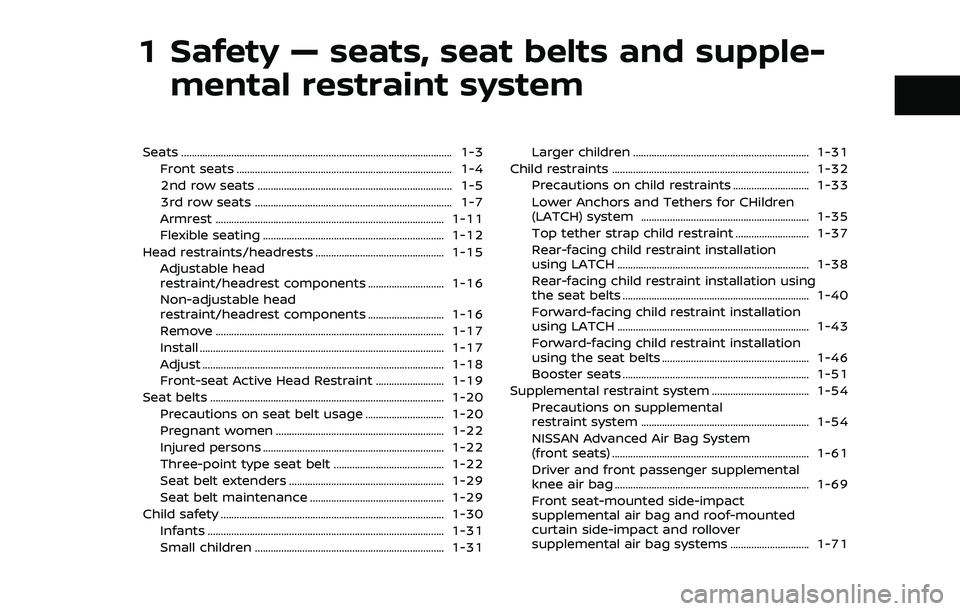
1 Safety — seats, seat belts and supple-mental restraint system
Seats ........................................................................\
............................... 1-3
Front seats ........................................................................\
.......... 1-4
2nd row seats ........................................................................\
.. 1-5
3rd row seats ........................................................................\
... 1-7
Armrest ........................................................................\
............... 1-11
Flexible seating ..................................................................... 1-12
Head restraints/headrests ................................................. 1-15 Adjustable head
restraint/headrest components ............................. 1-16
Non-adjustable head
restraint/headrest components ............................. 1-16
Remove ........................................................................\
............... 1-17
Install ........................................................................\
..................... 1-17
Adjust ........................................................................\
.................... 1-18
Front-seat Active Head Restraint .......................... 1-19
Seat belts ........................................................................\
................. 1-20
Precautions on seat belt usage .............................. 1-20
Pregnant women ................................................................ 1-22
Injured persons ..................................................................... 1-22
Three-point type seat belt .......................................... 1-22
Seat belt extenders ........................................................... 1-29
Seat belt maintenance ................................................... 1-29
Child safety ........................................................................\
............. 1-30
Infants ........................................................................\
.................. 1-31
Small children ........................................................................\
1-31 Larger children ................................................................... 1-31
Child restraints ........................................................................\
... 1-32 Precautions on child restraints ............................. 1-33
Lower Anchors and Tethers for CHildren
(LATCH) system ................................................................ 1-35
Top tether strap child restraint ............................ 1-37
Rear-facing child restraint installation
using LATCH ........................................................................\
. 1-38
Rear-facing child restraint installation using
the seat belts ....................................................................... 1-40
Forward-facing child restraint installation
using LATCH ........................................................................\
. 1-43
Forward-facing child restraint installation
using the seat belts ........................................................ 1-46
Booster seats ....................................................................... 1-51
Supplemental restraint system ..................................... 1-54
Precautions on supplemental
restraint system ................................................................ 1-54
NISSAN Advanced Air Bag System
(front seats) ........................................................................\
... 1-61
Driver and front passenger supplemental
knee air bag ........................................................................\
.. 1-69
Front seat-mounted side-impact
supplemental air bag and roof-mounted
curtain side-impact and rollover
supplemental air bag systems .............................. 1-71
Page 72 of 604
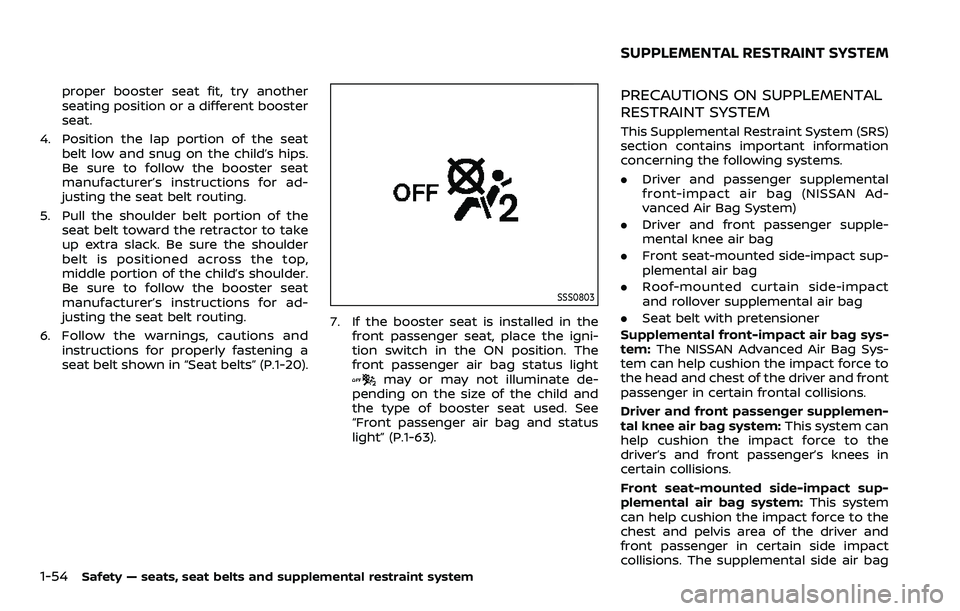
1-54Safety — seats, seat belts and supplemental restraint system
proper booster seat fit, try another
seating position or a different booster
seat.
4. Position the lap portion of the seat belt low and snug on the child’s hips.
Be sure to follow the booster seat
manufacturer’s instructions for ad-
justing the seat belt routing.
5. Pull the shoulder belt portion of the seat belt toward the retractor to take
up extra slack. Be sure the shoulder
belt is positioned across the top,
middle portion of the child’s shoulder.
Be sure to follow the booster seat
manufacturer’s instructions for ad-
justing the seat belt routing.
6. Follow the warnings, cautions and instructions for properly fastening a
seat belt shown in “Seat belts” (P.1-20).
SSS0803
7. If the booster seat is installed in thefront passenger seat, place the igni-
tion switch in the ON position. The
front passenger air bag status light
may or may not illuminate de-
pending on the size of the child and
the type of booster seat used. See
“Front passenger air bag and status
light” (P.1-63).
PRECAUTIONS ON SUPPLEMENTAL
RESTRAINT SYSTEM
This Supplemental Restraint System (SRS)
section contains important information
concerning the following systems.
. Driver and passenger supplemental
front-impact air bag (NISSAN Ad-
vanced Air Bag System)
. Driver and front passenger supple-
mental knee air bag
. Front seat-mounted side-impact sup-
plemental air bag
. Roof-mounted curtain side-impact
and rollover supplemental air bag
. Seat belt with pretensioner
Supplemental front-impact air bag sys-
tem: The NISSAN Advanced Air Bag Sys-
tem can help cushion the impact force to
the head and chest of the driver and front
passenger in certain frontal collisions.
Driver and front passenger supplemen-
tal knee air bag system: This system can
help cushion the impact force to the
driver’s and front passenger’s knees in
certain collisions.
Front seat-mounted side-impact sup-
plemental air bag system: This system
can help cushion the impact force to the
chest and pelvis area of the driver and
front passenger in certain side impact
collisions. The supplemental side air bag
SUPPLEMENTAL RESTRAINT SYSTEM
Page 73 of 604
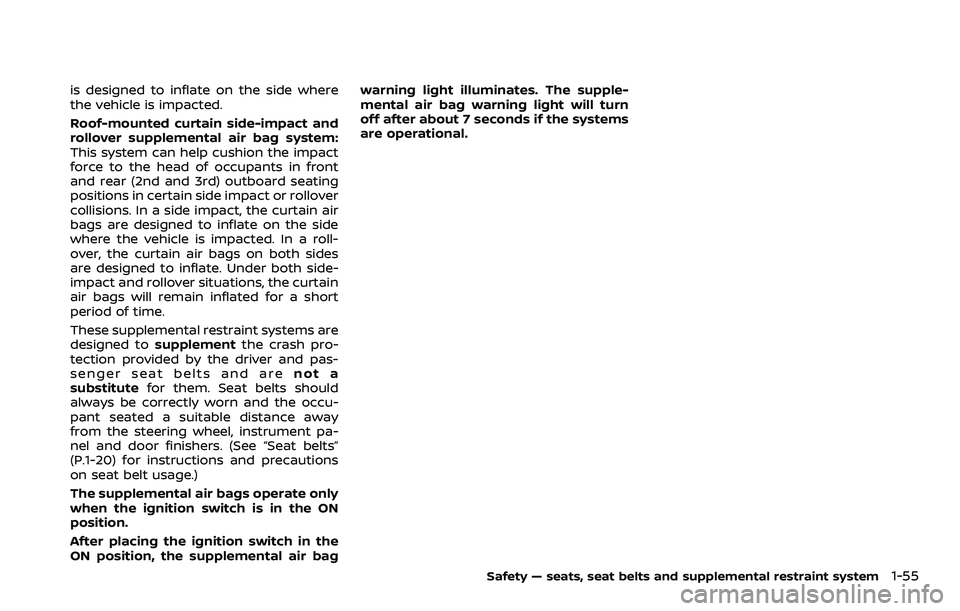
is designed to inflate on the side where
the vehicle is impacted.
Roof-mounted curtain side-impact and
rollover supplemental air bag system:
This system can help cushion the impact
force to the head of occupants in front
and rear (2nd and 3rd) outboard seating
positions in certain side impact or rollover
collisions. In a side impact, the curtain air
bags are designed to inflate on the side
where the vehicle is impacted. In a roll-
over, the curtain air bags on both sides
are designed to inflate. Under both side-
impact and rollover situations, the curtain
air bags will remain inflated for a short
period of time.
These supplemental restraint systems are
designed tosupplement the crash pro-
tection provided by the driver and pas-
senger seat belts and are not a
substitute for them. Seat belts should
always be correctly worn and the occu-
pant seated a suitable distance away
from the steering wheel, instrument pa-
nel and door finishers. (See “Seat belts”
(P.1-20) for instructions and precautions
on seat belt usage.)
The supplemental air bags operate only
when the ignition switch is in the ON
position.
After placing the ignition switch in the
ON position, the supplemental air bag warning light illuminates. The supple-
mental air bag warning light will turn
off after about 7 seconds if the systems
are operational.
Safety — seats, seat belts and supplemental restraint system1-55
Page 77 of 604
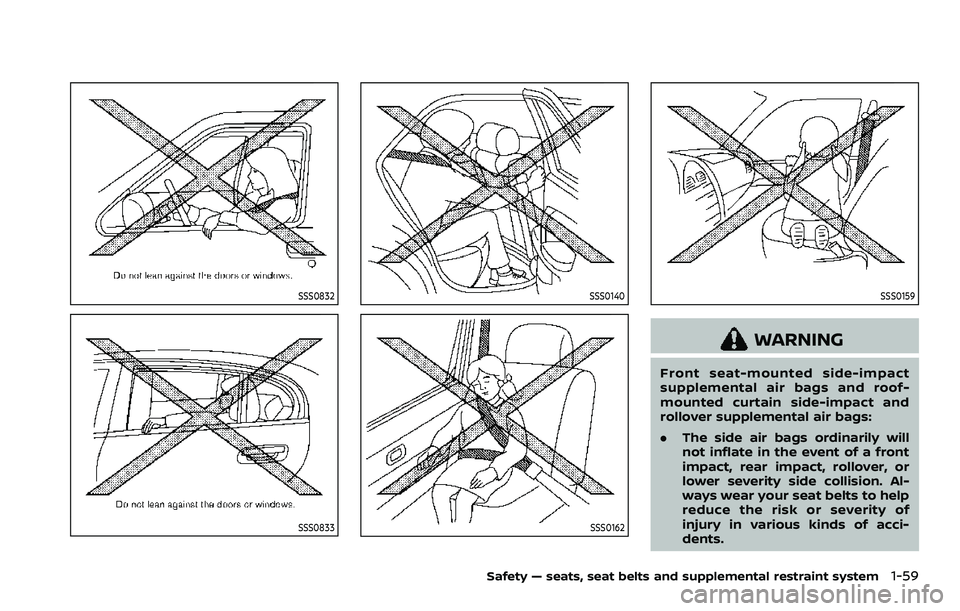
SSS0832
SSS0833
SSS0140
SSS0162
SSS0159
WARNING
Front seat-mounted side-impact
supplemental air bags and roof-
mounted curtain side-impact and
rollover supplemental air bags:
.The side air bags ordinarily will
not inflate in the event of a front
impact, rear impact, rollover, or
lower severity side collision. Al-
ways wear your seat belts to help
reduce the risk or severity of
injury in various kinds of acci-
dents.
Safety — seats, seat belts and supplemental restraint system1-59
Page 78 of 604
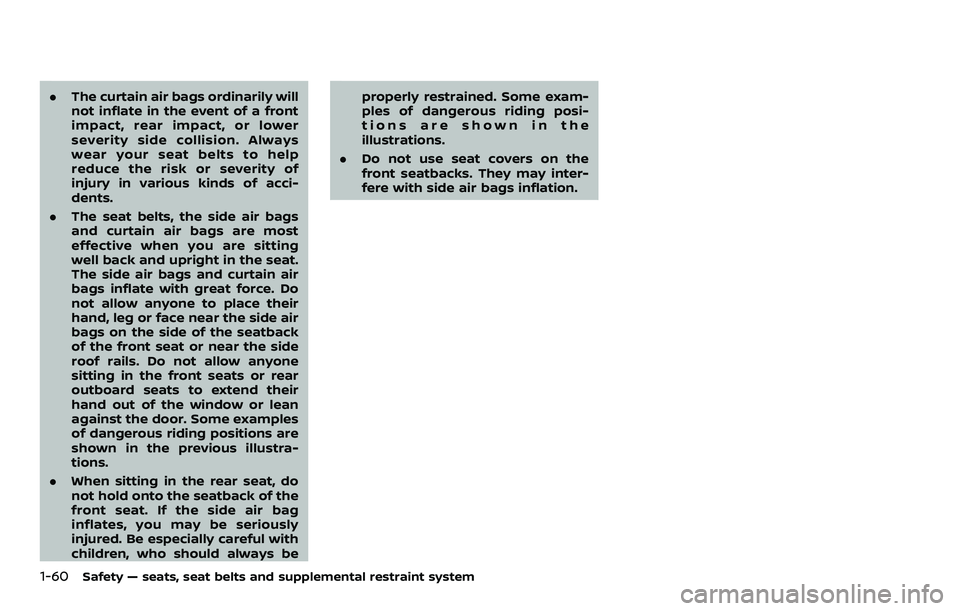
1-60Safety — seats, seat belts and supplemental restraint system
.The curtain air bags ordinarily will
not inflate in the event of a front
impact, rear impact, or lower
severity side collision. Always
wear your seat belts to help
reduce the risk or severity of
injury in various kinds of acci-
dents.
. The seat belts, the side air bags
and curtain air bags are most
effective when you are sitting
well back and upright in the seat.
The side air bags and curtain air
bags inflate with great force. Do
not allow anyone to place their
hand, leg or face near the side air
bags on the side of the seatback
of the front seat or near the side
roof rails. Do not allow anyone
sitting in the front seats or rear
outboard seats to extend their
hand out of the window or lean
against the door. Some examples
of dangerous riding positions are
shown in the previous illustra-
tions.
. When sitting in the rear seat, do
not hold onto the seatback of the
front seat. If the side air bag
inflates, you may be seriously
injured. Be especially careful with
children, who should always be properly restrained. Some exam-
ples of dangerous riding posi-
tions are shown in the
illustrations.
. Do not use seat covers on the
front seatbacks. They may inter-
fere with side air bags inflation.